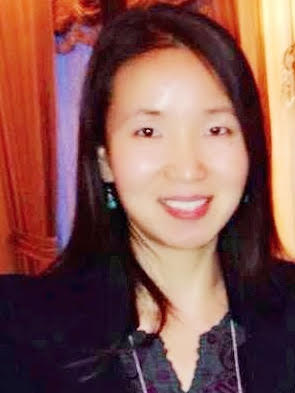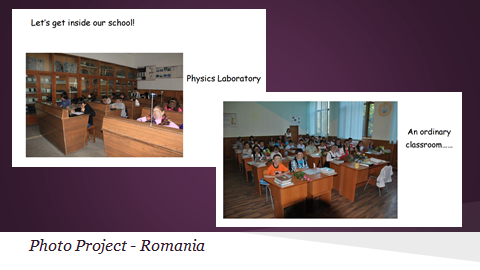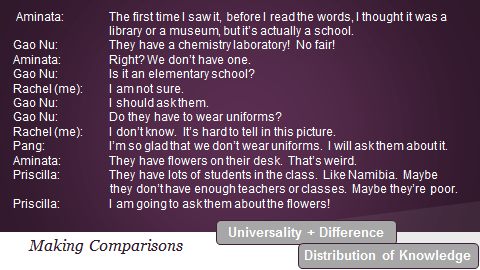|

Laura Hamman
|
|

Rui Li
|
|

Rachel Manley
|
Introduction
Discourses of globalization, centering on global flows of
information, people, and resources, have become increasingly prominent
in educational literature. These conversations are especially relevant
for English language learners (ELLs) who regularly move within and
across geopolitical and ideological borders. Many education scholars
have begun exploring the role of multimodal communication and digital
media in maintaining and extending borders, including possibilities for
fostering “critical cosmopolitanism” (Hawkins, 2014), which not only
considers global encounters, but, further, addresses ethical,
intellectual, and performative aspects of this type of
interconnectedness.
Cosmopolitanism is far from a new concept; scholars trace its
origin to ancient Greece where, in the 4th century BC, Diogenes deemed
himself a “kosmou polites,” or a citizen of the world
(Ong, 2009). This idea was reaffirmed during the Enlightenment era and
has been taken up across disciplines, largely as a political theory;
more recently, cosmopolitanism has extended into the social sphere to
consider the implications of increased global interconnectedness
(Delanty, 2006). However, scholars such as Hawkins (2014) argue that
existing literature on cosmopolitanism has not sufficiently engaged with
issues of power and privilege. Bringing the concept to bear on
education, she calls for a “critical cosmopolitan education” that
explicitly engages with social justice.
At the 2016 TESOL convention, we employed this critical lens to
consider how learning environments in classrooms and community-based
sites might be designed to expand understandings of learning, literacy,
and globalization. We presented findings from three studies that explore
how digital technology and communication shapes students’ development
of a critical cosmopolitan stance. In the first study, the author
examined the use of technology-enhanced learning environments to support
literacy and global awareness among adolescent ELLs. In the second, the
author shared findings from Global
StoryBridges, an afterschool program for preadolescent ELLs
that connects students through digital storytelling. In the third, the
author explored how digital tools fostered critical reflection for
preservice teachers who were teaching abroad. Together, these studies
provide a consideration of critical applications of digital technology
for ELLs and their teachers.
Literacy, Learning, and Globalization:
Technology-Enhanced Learning Environments for Youth
Rachel Manley
The qualitative study I presented examined the affordances and
challenges of using technology-enhanced learning environments to support
literacy and global awareness among youth in out-of-school contexts. I
was particularly interested in finding evidence of critical
cosmopolitanism while youth engaged in cross-cultural communication.
There were five participants, ages 9–11, all nonnative English speakers.
In this 6-week project, they engaged in cross-cultural interactions
through the ePals
website. They created and exchanged artwork, photos, and
videos and participated in online discussion forums with students from
Romania and Namibia. My data sources included observations, artifacts
(artwork, photos, movies), and student interviews.
I found two main patterns of understanding: making connections
and making comparisons. Making connections and comparing cultures were
common and consistent ways in which students made sense of transnational
communication. For example, the U.S. students viewed a photo tour of a
Romanian school. The discussion that followed showed evidence of
students making connections and comparisons with their experiences (see
Figure 1). Making connections allowed learners to see the broader global
context of their interactions, while making comparisons situated
students in relation to global others. These ways of understanding are
indicators that students are engaged in cosmopolitan practices and
working toward more globally conscious selves.


Figure 1. U.S. students’ discussion of Romanian school photo tour
The findings from interviews suggest a shared belief in the
importance of cross-cultural communication and global awareness among
students and staff at the community center. Some learners expressed
their desire for more general knowledge about other cultures, while
others argued that global awareness is necessary for successful
cross-cultural interactions and relationships. As one student explained,
“It is important to learn about
how people are the same and different from you, and what their lives
are like.”
Digital Stories as Global Bridges: Language, Culture, and Critical Cosmopolitan Education
Rui Li
This study explores how digitally-mediated learning in
community-based sites can amplify understandings of language and
culture. Global
StoryBridges is an afterschool program created by Professor
Margaret Hawkins that uses digital storytelling to link global ELLs
(ages 11–12) living in poverty. Using iMovie and Flip cameras, youth
collaboratively create and share digital stories with global peers. They
also post and answer questions (in English) regarding others’ videos
posted on the project website. The project aims to provide equal access
to digital transnational communication and to foster social justice
(Hawkins, 2014). As the project coordinator, I examined how children
engaged with digital storytelling and transnational communication
reconstruct their cultural and linguistic worlds. Approaching this
critically, I explored how project activities illuminate issues of
power, status, and privilege.
From my data analysis, I found that the project provided space
for learners to explore cosmopolitan identities through conversations
about language. For instance, after the Ugandan children posted a video
in which they sang hymns in Luganda, their local language, the students
from the Chinese site asked, “What language was your song?” and students
from the U.S. site (also ELLs) commented, “Do you try to teach your
parents English? Sometimes we try to teach English to our parents, but
they still talk Spanish.” Language ideologies also emerged in the recent
“Winter Solstice” video, created by the Chinese children in written and
spoken English (see Figure 2). When U.S. children heard the accented
English in the video, they asked, “Can they speak English?” These
inquiries have inspired me to rethink language and privilege, prompting
new questions. Namely, whose English is legitimized? Whose language is
privileged and whose is ignored?

Figure 2. Chinese students’ video “Winter Solstice”
My broader findings show that ELLs can become critical
knowledge designers, producers, and transformers through collaborative
digitally-mediated, transnational communication. By integrating texts,
images, audio and other multimodal resources, students developed
critical understandings of their imagined worlds (Hull & Katz,
2006). Thus, I argue for critical multimodal
cosmopolitan education for ELLs, one that redefines “knowledge” and
“learning” in the digital era to value children’s multiple repertoires
beyond language and that reconceptualizes equitable human
relationships.
Fostering Critical Reflection With Preservice Teachers
Laura Hamman
In my study, I explored how digital tools shape preservice ESL
teachers’ reflections and foster critical cosmopolitanism. I was
particularly interested in the experiences of undergraduates who were
student teaching in low-income communities in Mexico and Uganda. This
project developed out of my own interest as their elementary ESL methods
instructor. There were seven participants in the study, all of whom
were women and most of whom were White. The digital artifacts included
students’ weekly blog posts, course discussion posts, and summative
digital stories. Participants were interviewed twice in focus
groups.
After analyzing interview data, three themes emerged as
contributing to critical reflection: authenticity, autonomy, and
audience. Authenticity was an important element of the digital stories,
which were, in the words of one participant, “a good format for just
authentic talking about what people are feeling and thinking.” Through
digital stories, dispositions of critical cosmopolitanism emerged, which
included viewing all students as capable, engaging in critical
self-reflection, and developing caring toward global others.
Autonomy was salient in students’ discussion of their
individual blogs, a space to freely grapple with issues—unlike the more
structured discussion prompts. One participant, Rebecca, explained that
her blog was about “more than just those random experiences…like
safaris…I wanted it to actually reflect what I was thinking about my
experiences…” In one entry, she critically reflected upon constructions
of race and identity, interrogating the ways her Ugandan students
understood “being American”:
These moments have just made me
think of the “single” stories that I would say some of my students, if
not all, have seen, experienced, and heard about Whiteness. How many
teachers from Canada, Australia, and America have they had come to them?
How many were White? How many were of African descent? What about the
tourists they have seen? What were they like? What did they look like?
What about the media? Granted my student’s [sic]
favorite musicians are majority Black-American, but how else have they
been inundated with a single story of what it means to be American. From
what I’ve heard from my students it seems pretty white washed.
(Rebecca, 2015, October 3)
Finally, students described the importance of having a
meaningful audience. Jamie shared her blog with family and friends,
“putting it in a way that was relevant or understandable for people who
are outside of the education field.” Another participant played her
digital story at her graduation party. Because the digital story and
blog embodied the “3 A’s” (authenticity, autonomy, and audience), they
transcended the classroom and provided students with a platform for
engaging with critical cosmopolitanism perspectives in a way that the
structured discussion board did not. Thus, I believe that digital
technologies aimed at fostering critical cosmopolitanism should be
designed to provide authentic and autonomous spaces for reflection, with
a format that facilitates sharing emerging understandings.
Conclusion
These brief summaries reveal different ways to engage with
digital technologies to foster critical cosmopolitanism. Manley’s
project showed how making connections and comparisons with global others
is an important first step in achieving critical cosmopolitanism. Li demonstrated how language ideologies emerge through digital
storytelling, providing a platform for critical conversations. Finally,
Hamman revealed that certain conditions should be met for critical
reflection to emerge from digital technology; namely, the tool itself
must promote authenticity, provide autonomy, and have a meaningful
audience. We argue that each of these projects demonstrates how students
are approaching critical cosmopolitanism and that
further research is needed to explore how digital technology can be
leveraged to deepen students’ understanding of the world and foster
socially just attitudes and actions toward global others.
References
Delanty, G. (2006). Cosmopolitan imagination: Critical
cosmopolitanism and social theory. Journal of
Sociology, 57(1), 25–47.
Hawkins, M. R. (2014). Ontologies of place, creative meaning
making and critical cosmopolitan education. Curriculum
Inquiry, 44(1), 90–112.
Hull, G. A., & Katz, M.-L. (2006). Crafting an agentive
self: Case studies of digital storytelling. NCTE, 41(1), 43–81.
Ong, J. C. (2009). The cosmopolitan continuum: Locating
cosmopolitanism in media and cultural studies. Media, Culture
& Society, 31(3),
449–466.
Laura Hamman is a PhD candidate at the University of
Wisconsin-Madison. Her dissertation research explores the role of
translanguaging practices and pedagogies in dual language immersion
classrooms. Laura teaches courses in ESL methods, SLA, and educational
linguistics, and she supervises teachers obtaining ESL
certification.
Rui Li is a PhD candidate at the University of
Wisconsin-Madison. Her research focuses on global youth engagement with
multilingual and multimodal learning and identity formation through
transnational media.
Rachel Manley taught for 8 years and now works as a
project coordinator for iEARN-USA. She completed her MEd at the
University of Wisconsin-Madison. Her professional interests include
understanding how technology-enhanced environments can improve literacy
and understanding of global others. |

